A Review on the Properties and Applications of WO3 Nanostructure−Based Optical and Electronic Devices
Abstract
1. Introduction
2. Photodetector
2.1. UV Photodetector
2.1.1. Nanostructured WO3 Photodetector
2.1.2. WO3 Thin Films for UV Photodetector
2.2. Visible Photodetectors
3. Light-Emitting Diode
4. Photoluminescence Properties
5. Electrical Properties
5.1. Nanostructured WO3 Electrical Properties
5.1.1. Oxygen Vacancy Effect
5.1.2. Electrical Transport Behavior
5.1.3. Field Emission Properties
5.2. WO3 Thin Film Electrical Properties
6. Memory Application
7. Conclusions and Future Outlook
Author Contributions
Funding
Data Availability Statement
Acknowledgments
Conflicts of Interest
References
- Yu, P.; Yang, H.; Chen, X.; Yi, Z.; Yao, W.; Chen, J.; Yi, Y.; Wu, P. Ultra-wideband solar absorber based on refractory titanium metal. Renew. Energy 2020, 158, 227–235. [Google Scholar] [CrossRef]
- Zhao, F.; Chen, X.; Yi, Z.; Qin, F.; Tang, Y.; Yao, W.; Zhou, Z.; Yi, Y. Study on the solar energy absorption of hybrid solar cells with trapezoid-pyramidal structure based PEDOT:PSS/c-Ge. Sol. Energy 2020, 204, 635–643. [Google Scholar] [CrossRef]
- Najafi-Ashtiani, H.; Bahari, A.; Ghasemi, S. A Dual electrochromic film based on nanocomposite of copolymer and WO3 nanoparticles: Enhanced electrochromic coloration efficiency and switching response. J. Electroanal. Chem. 2016, 774, 14–21. [Google Scholar] [CrossRef]
- Najafi-Ashtiani, H.; Bahari, A. Optical, structural and electrochromic behavior studies on nanocomposite thin film of aniline, o-toluidine and WO3. Opt. Mater. 2016, 58, 210–218. [Google Scholar] [CrossRef]
- Yue, S.; Pan, H.; Ning, Z.; Yin, J.; Wang, Z.; Zhang, G. Amazing ageing property and in situ comparative study of field emission from tungsten oxide nanowires. Nanotechnology 2011, 22, 115703. [Google Scholar] [CrossRef] [PubMed]
- Teoh, L.G.; Shieh, J.; Lai, H.W.; Hung, I.M.; Hon, M.H. Structure and optical properties of mesoporous tungsten oxide. J. Alloy. Compd. 2005, 396, 251–254. [Google Scholar] [CrossRef]
- Dai, J.; Li, Y.; Ruan, H.; Ye, Z.; Chai, N.; Wang, X.; Qiu, S.; Bai, W.; Yang, M. Fiber optical hydrogen sensor based on WO3-Pd2Pt-Pt nanocomposite films. Nanomaterials 2021, 11, 128. [Google Scholar] [CrossRef]
- Lin, H.; Long, X.; An, Y.; Yang, S. In situ growth of Fe2WO6 on WO3 nanosheets to fabricate heterojunction arrays for boosting solar water splitting. J. Chem. Phys. 2020, 152, 214704. [Google Scholar] [CrossRef]
- Fularz, A.; Almohammed, S.; Rice, J.H. Controlling plasmon-induced photocatalytic redox reactions on WO3 nanowire/AgNPs substrates via defect engineering. J. Phys. Chem. C 2020, 124, 25351–25360. [Google Scholar] [CrossRef]
- Ji, Y.; Yang, Y.; Lee, S.K.; Ruan, G.; Kim, T.W.; Fei, H.; Lee, S.H.; Kim, D.Y.; Yoon, J.; Tour, J.M. Flexible nanoporous WO3−x nonvolatile memory device. ACS Nano 2016, 10, 7598–7603. [Google Scholar] [CrossRef]
- Sun, J.; Zhang, S.; Zhan, T.; Liu, Z.; Wang, J.; Yi, X.; Li, J.; Sarro, P.M.; Zhang, G. A high responsivity and controllable recovery ultraviolet detector based on a WO3 gate AlGaN/GaN heterostructure with an integrated micro-heater. J. Mater. Chem. C 2020, 8, 5409–5416. [Google Scholar] [CrossRef]
- Karthik, Y.P.V.; Ajitha, B.; Kumar Reddy, Y.A.; Minnam Reddy, V.R.; Reddeppad, M.; Kim, M.D. Effect of sputter pressure on UV photodetector performance of WO3 thin films. Appl. Surf. Sci. 2021, 536, 147947. [Google Scholar] [CrossRef]
- Gaewdang, T.; Wongcharoen, N. Temperature-dependent electrical transport characteristics of p-SnS/n-WO3:Sb heterojunction diode. Mater. Sci. Eng. 2018, 383, 012006. [Google Scholar] [CrossRef]
- Wang, L.; Cheng, S.; Wu, C.; Pei, K.; Song, Y.; Li, H.; Wang, Q.; Sang, D. Fabrication and high temperature electronic behaviors of n-WO3 nanorods/p-diamond heterojunction. Appl. Phys. Lett. 2017, 110, 052106. [Google Scholar] [CrossRef]
- Kim, Y.H.; Lee, S.Y.; Umh, H.N.; Song, H.D.; Han, J.W.; Choi, J.W.; Yi, J. Directional change of interfacial electric field by carbon insertion in heterojunction system TiO2/WO3. ACS Appl. Mater. Interfaces 2020, 12, 15239–15245. [Google Scholar] [CrossRef] [PubMed]
- Zhang, J.; Lu, H.; Liu, C.; Chen, C.; Xin, X. Porous NiO-WO3 heterojunction nanofibers fabricated by electrospinning with enhanced gas sensing properties. RSC Adv. 2017, 7, 40499–40509. [Google Scholar] [CrossRef]
- Li, N.; Fu, S.; Wu, J.; Li, X.; Zhou, J.; Wang, Y.; Zhang, X.; Liu, Y. WO3/ZnO nanowire heterojunction as hole transport channel for building up persistent holographic fringes. Appl. Phys. Lett. 2020, 116, 251606. [Google Scholar] [CrossRef]
- Yin, C.; Zhu, S.; Zhang, D. 3D nanostructured WO3/BiVO4 heterojunction derived from Papilio paris for efficient water splitting. RSC Adv. 2017, 7, 27354. [Google Scholar] [CrossRef]
- Tahir, M.B.; Ali, S.; Rizwan, M. A review on remediation of harmful dyes through visible light-driven WO3 photocatalytic nanomaterials. Int. J. Environ. Sci. Technol. 2019, 16, 4975–4988. [Google Scholar] [CrossRef]
- Dutta, V.; Sharma, S.; Raizada, P.; Thakur, V.K.; Khan, A.A.P.; Saini, V.; Asiri, A.M.; Singh, P. An overview on WO3 based photocatalyst for environmental remediation. J. Environ. Chem. Eng. 2021, 9, 105018. [Google Scholar] [CrossRef]
- Mehmood, A.; Long, X.; Haidry, A.A.; Zhang, X. Trends in sputter deposited tungsten oxide structures for electrochromic applications: A review. Ceram. Int. 2020, 46, 23295–23313. [Google Scholar] [CrossRef]
- Zhong, X.; Liu, X.; Diao, X. Electrochromic devices based on tungsten oxide and nickel oxide: A review. J. Inorg. Mater. 2021, 36, 128–139. [Google Scholar] [CrossRef]
- Dong, C.; Zhao, R.; Yao, L.; Ran, Y.; Zhang, X.; Wang, Y. A review on WO3 based gas sensors: Morphology control and enhanced sensing properties. J. Alloy. Compd. 2020, 15, 153194. [Google Scholar] [CrossRef]
- Wei, Z.; Xu, L.; Peng, S.; Zhou, Q. Application of WO3 Hierarchical structures for the detection of dissolved gases in transformer oil: A mini review. Front Chem. 2020, 8, 188. [Google Scholar] [CrossRef]
- Bandi, S.; Srivastav, A.K. Review: Oxygen-deficient tungsten oxides. J. Mater. Sci. 2021, 56, 6615–6644. [Google Scholar] [CrossRef]
- Bechinger, C.; Wirth, E.; Leiderer, P. Photochromic coloration of WO3 with visible light. Appl. Phys. Lett. 1996, 68, 2834–2836. [Google Scholar] [CrossRef]
- Wang, H.; Liu, J.L.; Wu, X.X.; Zhang, S.Q.; Zhang, Z.K.; Pan, W.W.; Yuan, G.; Yuan, C.L.; Ren, Y.L.; Lei, W. Ultra-long high quality catalyst-free WO3 nanowires for fabricating high-performance visible photodetectors. Nanotechnology 2020, 31, 274003. [Google Scholar] [CrossRef]
- Li, X.L.; Lou, T.J.; Sun, X.M.; Li, Y.D. Highly sensitive WO3 hollow-sphere gas sensors. Inorg. Chem. 2004, 43, 5442–5449. [Google Scholar] [CrossRef]
- Huo, N.; Yang, S.; Wei, Z.; Li, J. Synthesis of WO3 nanostructures and their ultraviolet photoresponse properties. J. Mater. Chem. C 2013, 1, 3999–4007. [Google Scholar] [CrossRef]
- Li, L.; Zhang, Y.; Fang, X.; Zhai, T.; Liao, M.; Sun, X.; Koide, Y.; Bando, Y.; Golberg, D. WO3 nanowires on carbon papers: Electronic transport, improved ultraviolet-light photodetectors and excellent field emitters. J. Mater. Chem. 2011, 21, 6525–6530. [Google Scholar] [CrossRef]
- Liu, J.; Zhong, M.; Li, J.; Pan, A.; Zhu, X. Few-layer WO3 nanosheets for high-performance UV-photodetectors. Mater. Lett. 2015, 148, 184–187. [Google Scholar] [CrossRef]
- Wan, J.H.; Huang, K.; Wan, L. Shottky contact device based on a single WO3 nanowire for ultraviolet photodetector. Appl. Mech. Mater. 2014, 556, 2097–2100. [Google Scholar] [CrossRef]
- Kim, Y.; Lee, S.H.; Jeong, S.; Kim, B.J.; Choi, J.Y.; Yu, H.K. Conversion of WO3 thin films into self-crosslinked nanorods for large-scale ultraviolet detection. RSC Adv. 2020, 10, 14147–14153. [Google Scholar] [CrossRef]
- Kumar Reddy, Y.A.; Ajitha, B.; Sreedhar, A.; Eswaraiah, V. Enhanced UV photodetector performance in bi-layer TiO2/WO3 sputtered films. Appl. Surf. Sci. 2019, 494, 575–582. [Google Scholar] [CrossRef]
- Karthik Yadava, P.V.; Kumar Reddy, Y.A.; Ajitha, B.; Minnam Reddyc, V.R. Oxygen partial pressure dependent UV photodetector performance of WO3 sputtered thin films. J. Alloy. Compd. 2020, 816, 152565. [Google Scholar] [CrossRef]
- Marnadu, R.; Chandrasekaran, J.; Maruthamuthu, S.; Balasubramani, V.; Vivek, P.; Suresh, R. Ultra-high photoresponse with superiorly sensitive metal-insulator-semiconductor (MIS) structured diodes for UV photodetector application. Appl. Surf. Sci. 2019, 480, 308–322. [Google Scholar] [CrossRef]
- Marnadu, R.; Chandrasekaran, J.; Maruthamuthu, S.; Vivek, P.; Balasubramani, V.; Balraju, P. Jet nebulizer sprayed WO3-nanoplate arrays for high-photoresponsivity based metal–insulator–semiconductor structured schottky barrier diodes. J. Inorg. Organomet. Polym. Mater. 2020, 30, 731–748. [Google Scholar] [CrossRef]
- Raj, M.; Joseph, C.; Subramanian, M.; Perumalsamy, V.; Elayappan, V. Superior photoresponse MIS Schottky barrier diodes with nanoporous: Sn-WO3 films for ultraviolet photodetector application. N. J. Chem. 2020, 44, 7708–7718. [Google Scholar] [CrossRef]
- Zhang, X.; Su, Y.; Tang, Z.; Hu, D.; Wang, Z.; Hou, Y.; Wang, X. WO3−x/Si n-n homotype heterojunction with high performance photodetection characteristics. Scr. Mater. 2020, 189, 89–94. [Google Scholar] [CrossRef]
- Kavithaa, V.S.; Krishnana, R.R.; Sreedharana, R.S.; Suresh, K.; Jayasankar, C.K.; Mahadevan Pillai, V.P. Tb3+-doped WO3 thin films: A potential candidate in white light emitting devices. J. Alloy. Compd. 2019, 788, 429–445. [Google Scholar] [CrossRef]
- Zhang, H.; Dai, Y.; Ma, D. Al/WO3/Au as the interconnecting layer for efficient tandem white organic light-emitting diodes. J. Phys. D Appl. Phys. 2008, 41, 102006. [Google Scholar] [CrossRef]
- Wei, F.; Fang, L. Pure-blue tandem OLEDs based on terfluorenes compounds. J. Mater. Sci. Mater. Electron. 2008, 19, 1202–1205. [Google Scholar] [CrossRef]
- Bao, Q.Y.; Yang, J.P.; Tang, J.X.; Li, Y.; Lee, C.S.; Lee, S.T. Interfacial electronic structures of WO3-based intermediate connectors in tandem organic light-emitting diodes. Org. Electron. 2010, 11, 1578–1583. [Google Scholar] [CrossRef]
- Bin, J.K.; Lee, N.Y.; Lee, S.; Seo, B.; Yang, J.H.; Kim, J.; Yoon, S.Y.; Kang, I. Two stacked tandem white organic light-emitting diodes employing WO3 as a charge generation layer. Org. Light Emit. Mater. Devices 2016, 9941, 99411T. [Google Scholar]
- Zhuo, M.P.; Liang, F.; Shi, Y.L.; Yun, H.; Wang, R.B.; Chen, W.F.; Wang, X.D.; Liao, L.S. WO3 nanobelt doped PEDOT:PSS layers for efficient hole-injection in quantum dot light-emitting diodes. J. Mater. Chem. C 2017, 5, 12343–12348. [Google Scholar] [CrossRef]
- Zhu, W.; Chen, X.L.; Chang, J.; Yu, R.M.; Li, H.; Liang, D.; Wu, X.Y.; Wang, Y.; Lu, C.Z. Doped polyaniline-hybridized tungsten oxide nanocrystals as hole injection layers for efficient organic light-emitting diodes. J. Mater. Chem. C 2018, 6, 7242–7248. [Google Scholar] [CrossRef]
- Manfredi, M.; Paracchini, C.; Salviati, G.C.; Schianchi, G. Conductive processes in transparent WO3 films irradiated with ultraviolet light. Thin Solid Film. 1981, 79, 161. [Google Scholar] [CrossRef]
- Niederberger, M.; Bartl, M.H.; Stucky, G.D. Benzyl alcohol and transition metal chlorides as a versatile reaction system for the nonaqueous and low-temperature synthesis of crystalline nano-objects with controlled dimensionality. J. Am. Chem. Soc. 2002, 124, 13642–13643. [Google Scholar] [CrossRef]
- Lee, K.; Seo, W.S.; Park, J.T. Synthesis and optical properties of colloidal tungsten oxide nanorods. J. Am. Chem. Soc. 2003, 125, 3408–3409. [Google Scholar] [CrossRef] [PubMed]
- Takagahara, T.; Takeda, K. Theory of the quantum confinement effect on excitons in quantum dots of indirect-gap materials. Phys. Rev. B 1992, 46, 15578. [Google Scholar] [CrossRef]
- Khold, A.N.; Shaposhnikov, V.L.; Sobolev, N.; Borisenko, V.E.; D’Avitaya, F.A.; Ossicini, S. Orientation effects in the electronic and optical properties of germanium quantum wires. Phys. Rev. B 2004, 70, 035317. [Google Scholar] [CrossRef]
- Feng, M.; Pan, A.L.; Zhang, H.R.; Li, Z.A.; Liu, F.; Liu, H.W.; Shi, D.X.; Zou, B.S.; Gao, H.J. Strong photoluminescence of nanostructured crystalline tungsten oxide thin films. Appl. Phys. Lett. 2005, 86, 141901. [Google Scholar] [CrossRef]
- Wang, J.; Lee, P.S.; Ma, J. Synthesis, growth mechanism and room-temperature blue luminescence emission of uniform WO3 nanosheets with W as starting material. J. Cryst. Growth 2009, 31, 316–319. [Google Scholar] [CrossRef]
- Park, S.; Kim, H.; Jin, C.; Lee, C. Intense ultraviolet emission from needle-like WO3 nanostructures synthesized by noncatalytic thermal evaporation. Nanoscale Res. Lett. 2011, 6, 451. [Google Scholar] [CrossRef]
- Luo, G.; Shen, L.; Zheng, J.; Xu, C.A. Europium ion doped WO3 film with the bi-functionality of enhanced electrochromic switching and tunable red emission. J. Mater. Chem. C 2017, 5, 3488–3494. [Google Scholar] [CrossRef]
- Ruan, J.; Yang, Z.; Huang, A.; Chai, Z.; Qiu, J.; Song, Z. Red photoluminescent property and modification of WO3:Eu3+ inverse opal for blue light converted LEDs. Opt. Mater. 2018, 75, 224–229. [Google Scholar] [CrossRef]
- Kovendhan, M.; Joseph, D.P.; Kumar, E.S.; Sendilkumar, A.; Manimuthu, P.; Sambasivam, S.; Venkateswaran, C.; Mohan, R. Structural transition and blue emission in textured and highly transparent spray deposited Li doped WO3 thin films. Appl. Surf. Sci. 2011, 257, 8127–8133. [Google Scholar] [CrossRef]
- Mukherjee, R.; Prajapati, C.S.; Sahay, P.P. Tin-incorporation induced changes in the microstructural, optical, and electrical behavior of tungsten oxide nanocrystalline thin films grown via spary pyrolysis. J. Therm. Spray Technol. 2014, 23. [Google Scholar]
- Mehmood, F.; Iqbal, J.; Jan, T.; Ahmed, W.; Ahmed, W.; Arshad, A.; Mansoor, Q.; Ilyas, S.Z.; Ismail, M.; Ahmad, I. Effect of Sn doping on the structural, optical, electrical and anticancer properties of WO3 nanoplates. Ceram. Int. 2016, 42, 14334–14341. [Google Scholar] [CrossRef]
- Kavitha, V.S.; Chalana, S.R.; Krishnan, R.R.; Gopchandran, K.G.; Mahadevan Pillai, V.P. High quality, highly transparent Cu incorporated WO3 thin films suitable for blue LED application. Vacuum 2020, 172, 109044. [Google Scholar] [CrossRef]
- Zheng, J.Y.; Haider, Z.; Van, T.K.; Pawar, A.U.; Kang, M.J.; Kim, C.W.; Kang, Y.S. Tuning of the crystal engineering and photo-electrochemical properties of crystalline tungsten oxide for optoelectronic device applications. CrystEngComm 2015, 17, 6070–6603. [Google Scholar] [CrossRef]
- Papadimitropoulos, G.; Vourdas, N.; Giannakopoulos, K.; Vasilopoulou, M.; Davazoglou, D. Porous hot-wire deposited WO3 films with high optical transmission. J. Appl. Phys. 2011, 109, 103527. [Google Scholar] [CrossRef]
- Xin, Y.; Zhou, H.; Ni, X.; Pan, Y.; Zhang, X.; Zheng, J.Y.; Bao, S.; Jin, P. The optical properties of low infrared transmittance WO3−x nanocrystal thin films prepared by DC magnetron sputtering under different oxygen ratios. RSC Adv. 2015, 5, 57757–57763. [Google Scholar] [CrossRef]
- Li, W.; Sasaki, A.; Oozu, H.; Aoki, K.; Kakushima, K.; Kataoka, Y.; Nishiyama, A.; Sugii, N.; Wakabayashi, H.; Tsutsui, K.; et al. Electron transport Mechanism of tungsten trioxide powder thin film studied by investigating the effect of annealing on resistivity. Microelectron. Reliab. 2015, 55, 407–410. [Google Scholar] [CrossRef]
- Teo, B.K.; Sun, X.H.; Hung, T.F.; Meng, X.M.; Wong, N.B.; Lee, S.T. Precision-cut crystalline silicon nanodots and nanorods from nanowires and direct visualization of cross sections and growth orientations of silicon nanowires. Nano Lett. 2003, 3, 1735. [Google Scholar] [CrossRef]
- Qian, C.; Kim, F.; Ma, L.; Tsui, F.; Yang, P.; Liu, J. Solution-Phase synthesis of single-crystalline iron phosphide nanorods/nanowires. J. Am. Chem. Soc. 2004, 126, 1195. [Google Scholar] [CrossRef]
- Acharya, S.; Efrima, S. Two-Dimensional pressure-driven nanorod-to-nanowire reactions in langmuir monolayers at room temperature. J. Am. Chem. Soc. 2005, 127, 3486–3490. [Google Scholar] [CrossRef]
- Yao, Y.; Sang, D.; Duan, S.; Wang, Q.; Liu, C. Excellent optoelectronic applications and electrical transport behavior of the n-WO3 nanostructures/p-diamond heterojunction: A new perspective. Nanotechnology 2021, 32, 332501. [Google Scholar] [CrossRef]
- Chen, J.; Ren, Y.M.; Hu, T.Z.; Xu, T.; Xu, Q. Fabrication and application of substoichiometric tungsten oxide with tunable localized surface plasmon resonances. Appl. Surf. Sci. 2019, 465, 517–525. [Google Scholar] [CrossRef]
- Cheng, H.F.; Klapproth, M.; Sagaltchik, A.; Li, S.; Thomas, A. Ordered mesoporous WO2.83: Selective reduction synthesis, exceptional localized surface plasmon resonance and enhanced hydrogen evolution reaction activity. J. Mater. Chem. A 2018, 6, 2249–2256. [Google Scholar] [CrossRef]
- Guo, T.C.; Ling, C.C.; Zhang, T.; Li, H.; Li, X.F.; Chang, X.; Zhu, L.; Zhao, L.; Xue, Q.Z. High-performance WO3−x-WSe2/SiO2/n-Si heterojunction near-infrared photodetector via a homo-doping strategy. J. Mater. Chem. C 2018, 6, 5821–5829. [Google Scholar] [CrossRef]
- Zhuiykov, S.; Kats, E. Enhanced electrical properties in sub-10-nm WO3 nanoflakes prepared via a two-step sol-gel-exfoliation method. Nanoscale Res. Lett. 2014, 401, 1–10. [Google Scholar] [CrossRef][Green Version]
- Sun, B.; Li, H.; Wei, L.; Chen, P. Hydrothermal synthesis and resistive switching behaviour of WO3/CoWO4 core–shell nanowires. CrystEngComm 2014, 16, 9891–9895. [Google Scholar] [CrossRef]
- Niklasson, G.A.; Berggren, L.; Larsson, A.L. Electrochromic tungsten oxide: The role of defects. Sol. Energy Mater. Sol. Cells 2004, 84, 315–328. [Google Scholar] [CrossRef]
- Gillet, M.; Lemire, C.; Gillet, E.; Aguir, K. The role of surface oxygen vacancies upon WO3 conductivity. Surf. Sci. 2003, 532, 519–525. [Google Scholar] [CrossRef]
- Shen, Z.; Zhao, Z.Y.; Wen, J.; Qian, J.; Peng, Z.; Fu, X. Role of oxygen vacancies in the electrical properties of WO3−x nano/microrods with identical morphology. J. Nanomater. 2018, 2018, 7802589. [Google Scholar] [CrossRef]
- Yang, W.; Yan, Y.; Peng, Y.; Zhao, G.; Liu, Y.; Li, S.; Wang, W.; Zhou, W.; Tang, D. Effect of oxygen vacancies on the resistive switching behavior of hexagonal WO3 nanowire. Mater. Res. Express 2019, 6, 085072. [Google Scholar] [CrossRef]
- Khan, A.A.; Khan, M.N.; Lqbal, M.; Majeed, A.; Jalil, A.; Mukhtar, S.; Javed, M. Temperature dependent charge conduction and relaxation mechanism study of nano-structure WO3 by impedance spectroscopy. Mater. Res. Express 2019, 6, 1250a5. [Google Scholar] [CrossRef]
- Lin, Z.; Zhan, R.; Chen, Y.; She, J.; Deng, S.; Xu, N.; Chen, J. Defective WO3−x nanowire: Possible long lifetime semiconductor nanowire point electron source. Nanoscale 2019, 11, 3370–3377. [Google Scholar] [CrossRef]
- Lin, Z.; Xie, P.; Zhan, R.; Chen, D.; She, J.; Deng, S.; Xu, N.; Chen, J. Defect-enhanced field emission from WO3 nanowires for flat-panel X-ray sources. ACS Appl. Nano Mater. 2019, 2, 5206–5213. [Google Scholar] [CrossRef]
- Garcia-Garcia, F.J.; Gil-Rostra, J.; Yubero, F.; González-Elipe, A.R. Electrochromism in WOx and WxSiyOz thin films prepared by Magnetron sputtering at glancing angles. Nanosci. Nanotechnol. Lett. 2013, 5, 89–93. [Google Scholar] [CrossRef]
- Garcia-Garcia, F.J.; Mosa, J.; Gonzalez-Elipe, A.R.; Aparicio, M. Sodium ion storage performance of magnetron sputtered WO3 thin films. Electrochim. Acta 2019, 321, 134669. [Google Scholar] [CrossRef]
- Samad, B.A.; Ashirt, P.V. Optimization of mixed conductivity through nanostructure control in WO3 thin films. Thin Solid Films 2017, 636, 717–722. [Google Scholar] [CrossRef]
- Shanmugasundaram, K.; Thirunavukkarasu, P.; Balaji, M. Effect of Sn doping on the structural, optical, electrical properties and diode characteristics of WO3 thin films deposited by Jet Nebulizer Spray technique. Mater. Today Proc. 2019, 18, 1648–1657. [Google Scholar] [CrossRef]
- Bartolomeo, A.D.; Giubileo, F.; Luongo, G.; Iemmo, L.; Martucciello, N.; Niu, G.; Fraschke, M.; Skibitzki, O.; Schroeder, T.; Lupina, G. Tunable Schottky barrier and high responsivity ingraphene/Si-nanotip optoelectronic device. 2D Mater. 2017, 4, 015024. [Google Scholar] [CrossRef]
- Raja, M.; Chandrasekaran, J.; Balaji, M.; Kathirvel, P. Investigation of microstructural, optical and dc electrical properties of spin coated Al:WO3 thin films for n-Al:WO3/p-Si heterojunction diodes. Optik 2017, 145, 169–180. [Google Scholar] [CrossRef]
- Akihito, S. Resistive switching in transition metal oxides. Mater. Today 2008, 11, 28–36. [Google Scholar]
- Kukreja, L.M.; Das, A.K.; Misra, P. Studies on nonvolatile resistance memory switching in ZnO thin films. Bull. Mater. Sci. 2009, 32, 247–252. [Google Scholar] [CrossRef][Green Version]
- Qu, B.; Younis, A.; Chu, D. Recent progress in tungsten oxides based memristors and their neuromorphological applications. Electron. Mater. Lett. 2016, 12, 715–731. [Google Scholar] [CrossRef]
- Kozicki, M.N.; Gopalan, C.; Balakrishnan, M.; Mitkova, M. A Low-power nonvolatile Switching element based on copper-tungsten oxide solid electrolyte. IEEE Trans. Nanotechnol. 2006, 5, 535–544. [Google Scholar] [CrossRef]
- Chien, W.C.; Chen, Y.C.; Lai, K.E.; Yao, Y.D.; Lin, P.; Horng, S.F.; Gong, J.; Chou, T.H.; Lin, H.M.; Chang, M.N.; et al. Unipolar switching behaviors of RTO WOx RRAM. IEEE Electron Device Lett. 2010, 31, 126–128. [Google Scholar] [CrossRef]
- Li, Y.T.; Long, S.B.; Lv, H.B.; Liu, Q.; Wang, Q.; Wang, Y.; Zhang, S.; Lian, W.T.; Liu, S.; Liu, M. Investigation of resistive switching behaviours in WO3-based RRAM devices. Chin. Phys. B 2011, 20, 017305. [Google Scholar] [CrossRef]
- Wu, W.T.; Wu, J.J.; Chen, J.S. Resistive switching behavior and multiple transmittance states in solution-processed tungsten oxide. ACS Appl. Mater. Interfaces 2011, 3, 2616–2621. [Google Scholar] [CrossRef] [PubMed]
- Yang, R.; Terabe, K.; Tsuruoka, T.; Hasegawa, T.; Aono, M. Oxygen migration process in the interfaces during bipolar resistance switching behavior of WO3−x-based nanoionics devices. Appl. Phys. Lett. 2012, 100, 231603. [Google Scholar] [CrossRef]
- Song, Y.Y.; Gao, Z.D.; Wang, J.H.; Xia, X.H.; Lynch, R. Multistage coloring electrochromic device based on TiO2 nanotube arrays modified with WO3 nanoparticles. Adv. Funct. Mater. 2011, 21, 1941–1946. [Google Scholar] [CrossRef]
- Habazaki, H.; Hayashi, Y.; Konno, H. Characterization of electrodeposited WO3 films and its application to electrochemical wastewater treatment. Electrochim. Acta 2002, 47, 4181–4188. [Google Scholar] [CrossRef]
- Deepa, M.; Kar, M.; Agnihotry, S.A. Electrodeposited tungsten oxide films: Annealing effects on structure and electrochromic performance. Thin Solid Films 2004, 468, 32–42. [Google Scholar] [CrossRef]
- Biswas, P.K.; Pramanik, N.C.; Mahapatra, M.K.; Ganguli, D.; Livage, J. Optical and electrochromic properties of sol-gel WO3 films on conducting glass. Mate. Lett. 2003, 57, 4429–4432. [Google Scholar] [CrossRef]
- Sharma, N.; Deepa, M.; Varshney, P.; Agnihotry, S.A. Influence of organic additive on the morphological, electrical and electrochromic properties of sol-gel derived WO3 coatings. J. Sol-Gel Sci. Technol. 2000, 18, 167–173. [Google Scholar] [CrossRef]
- Shim, H.S.; Kim, J.W.; Sung, Y.E.; Kim, W.B. Electrochromic properties of tungsten oxide nanowires fabricated by electrospinning method. Sol. Energy Mater. Sol. Cells 2009, 93, 2062–2068. [Google Scholar] [CrossRef]
- Pang, Y.; Chen, Q.; Shen, X.; Tang, L.; Qian, H. Size-controlled Ag nanoparticle modified WO3 composite films for adjustment of electrochromic properties. Thin Solid Films 2010, 518, 1920–1924. [Google Scholar] [CrossRef]
- Li, Y.; Long, S.; Liu, Q.; Wang, Q.; Zhang, M.; Lv, H.; Shao, L.; Wang, Y.; Zhang, S.; Zuo, Q.; et al. Nonvolatile multilevel memory effect in Cu/WO3/Pt device structures. Phys. Status Solidi RRL 2010, 4, 124–126. [Google Scholar] [CrossRef]
- Chakrabarti, S.; Samanta, S.; Maikap, S.; Rahaman, S.Z.; Cheng, H.M. Temperature-dependent non-linear resistive switching characteristics and mechanism using a new W/WO3/WOx/W structure. Nanoscale Res. Lett. 2016, 11, 1–8. [Google Scholar] [CrossRef] [PubMed]
- Sun, B.; Guo, T.; Zhou, G.; Ranjan, S.; Hou, W.; Hou, Y.; Zhao, Y. Tunneling of photon-generated carrier in the interface barrier induced resistive switching memory behaviour. J. Colloid Interface Sci. 2019, 553, 682–687. [Google Scholar] [CrossRef] [PubMed]
- Rajkumari, R.; Singh, N.K. Ag Nanoparticle-decorated WO3 nanowires for nonvolatile Memory. ACS Appl. Nano Mater. 2020, 3, 12087–12094. [Google Scholar] [CrossRef]
- Rajkumari, R.; Singh, N.K. Presence of capacitive memory in GLAD-synthesized WO3 nanowire. J. Mater. Sci. Mater. Electron 2021, 32, 3191–3200. [Google Scholar]
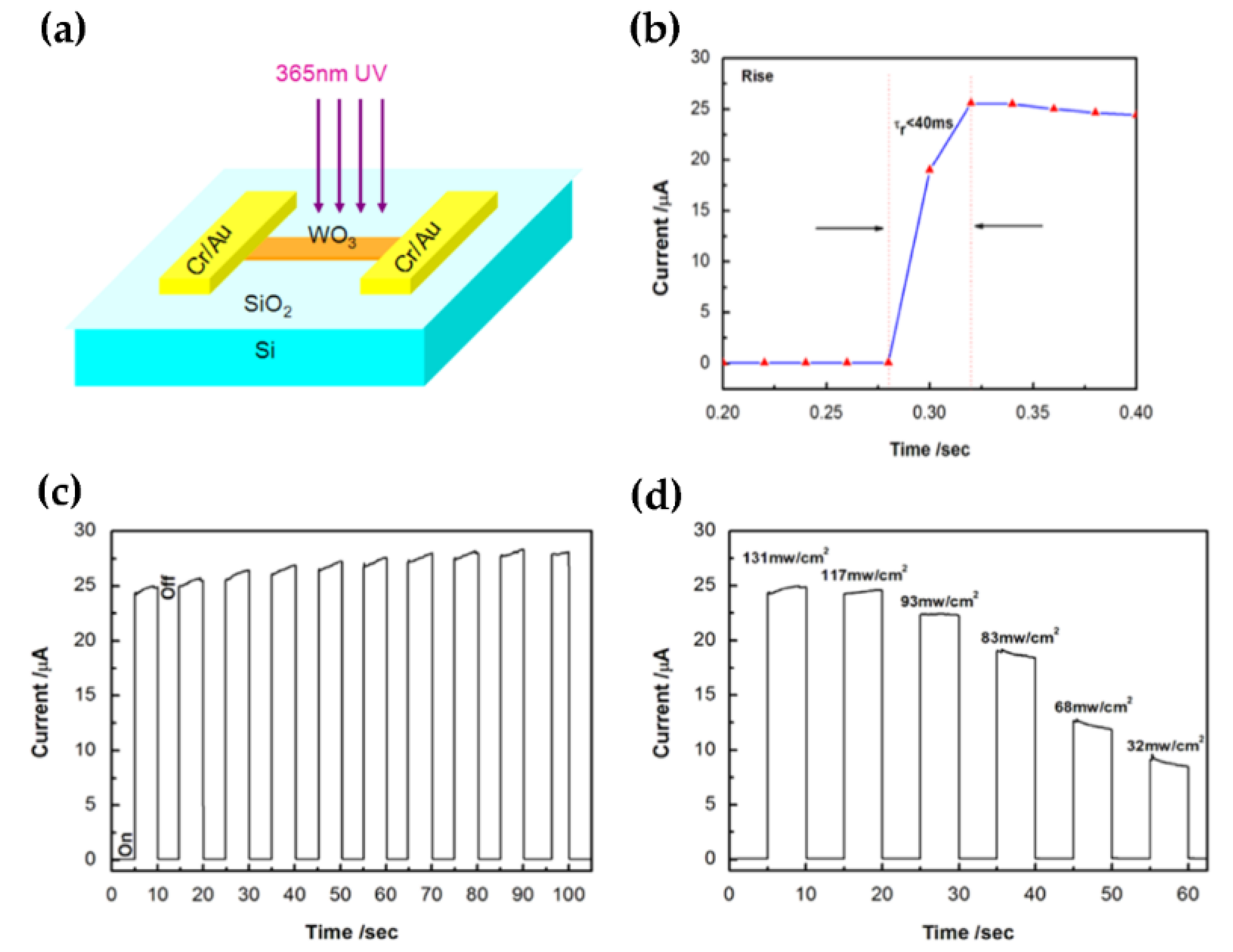
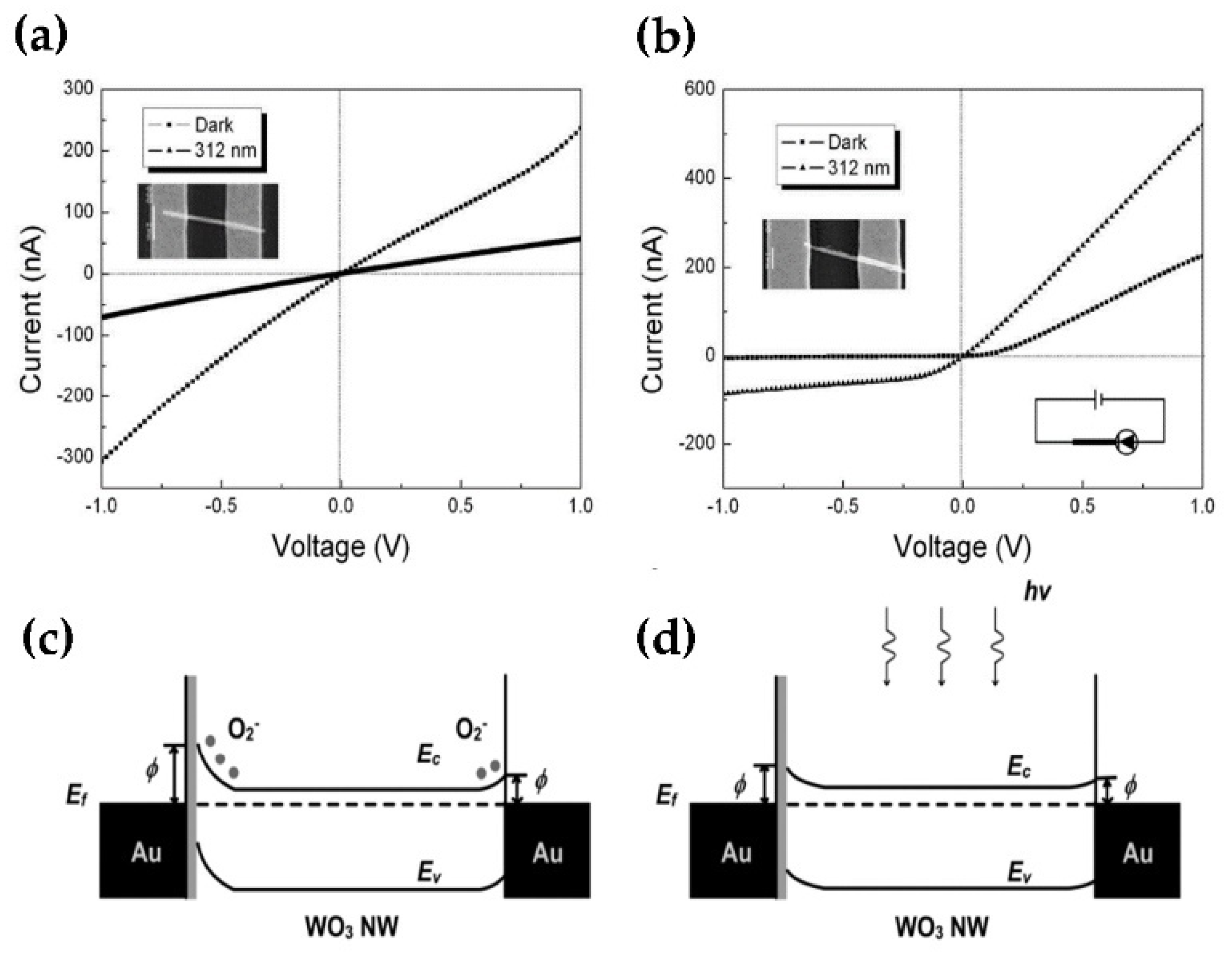

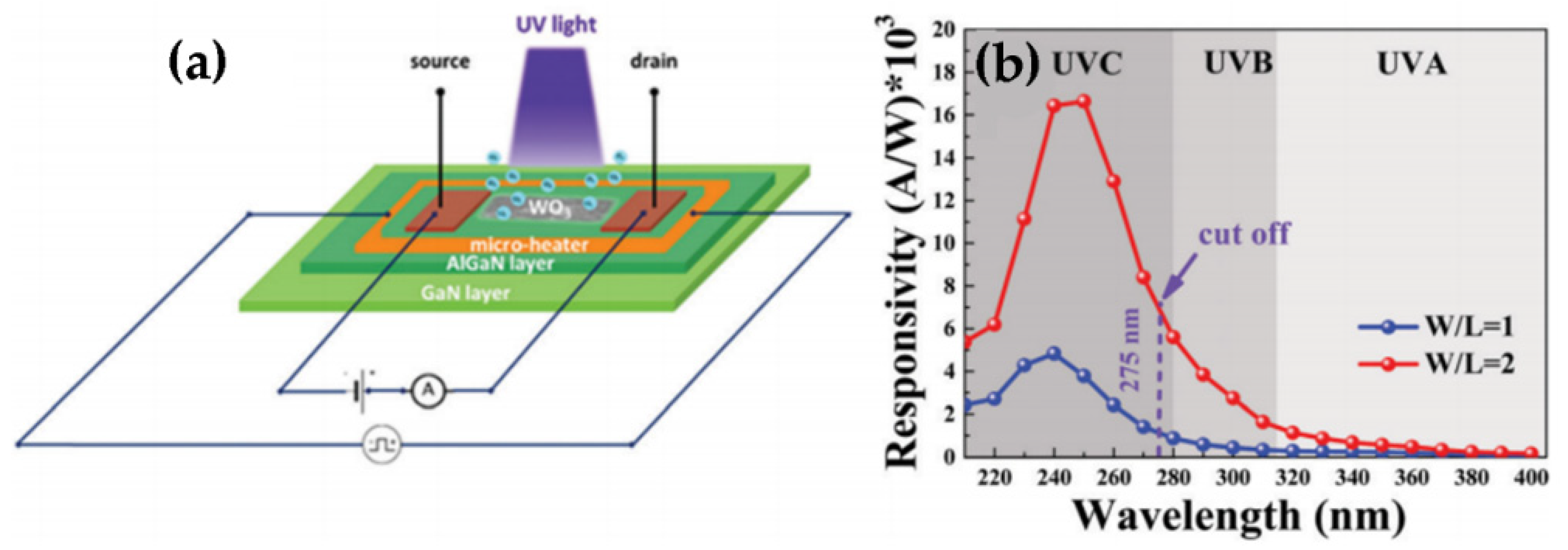
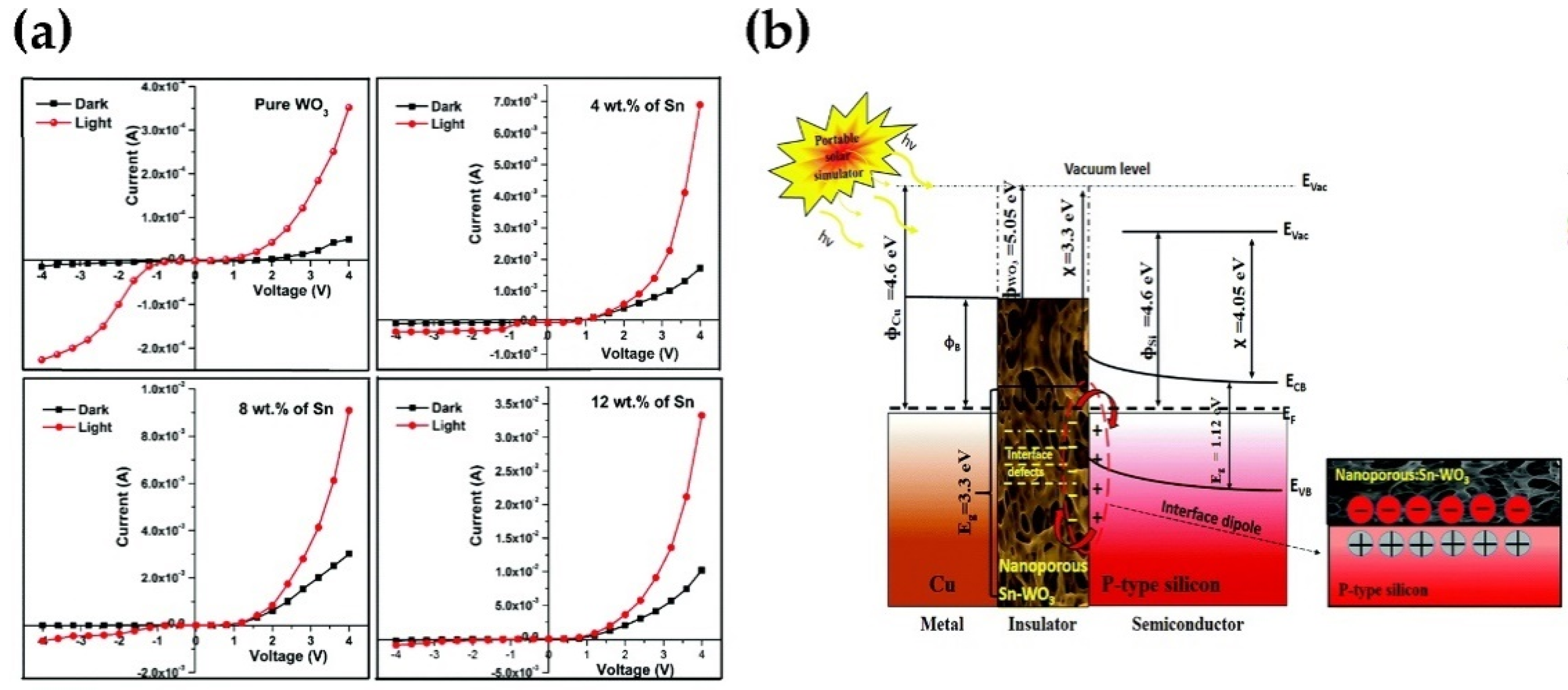
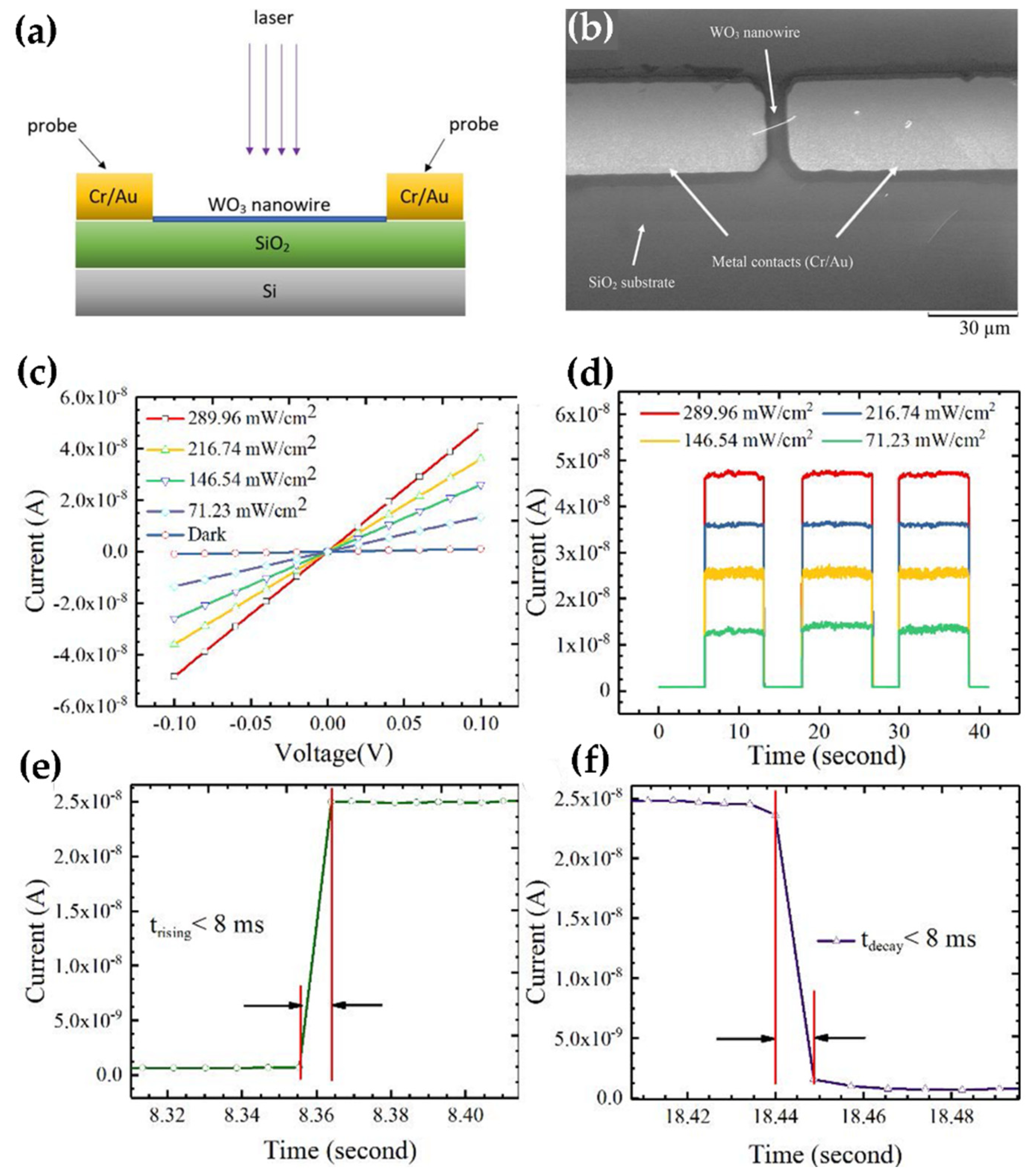


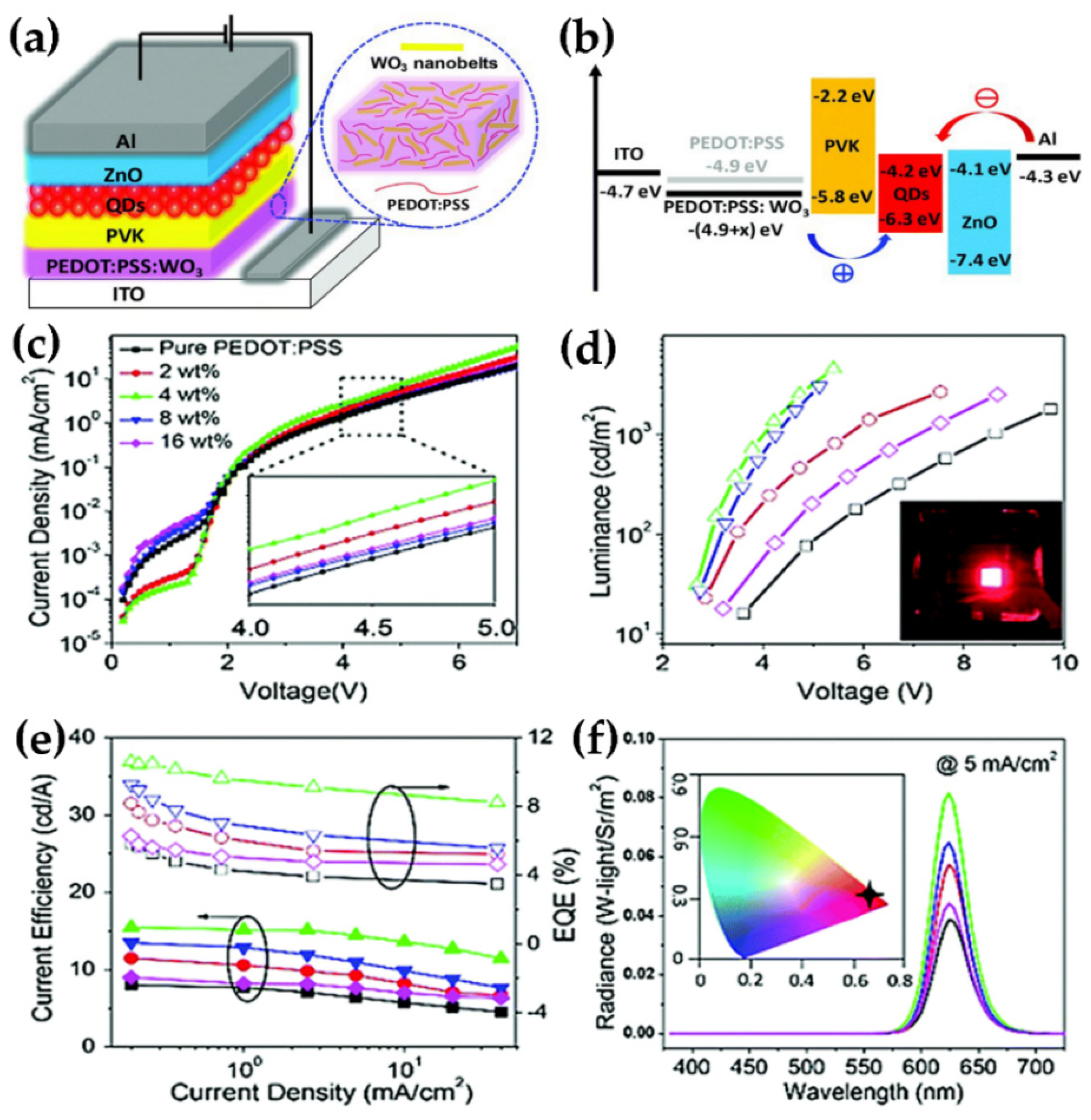
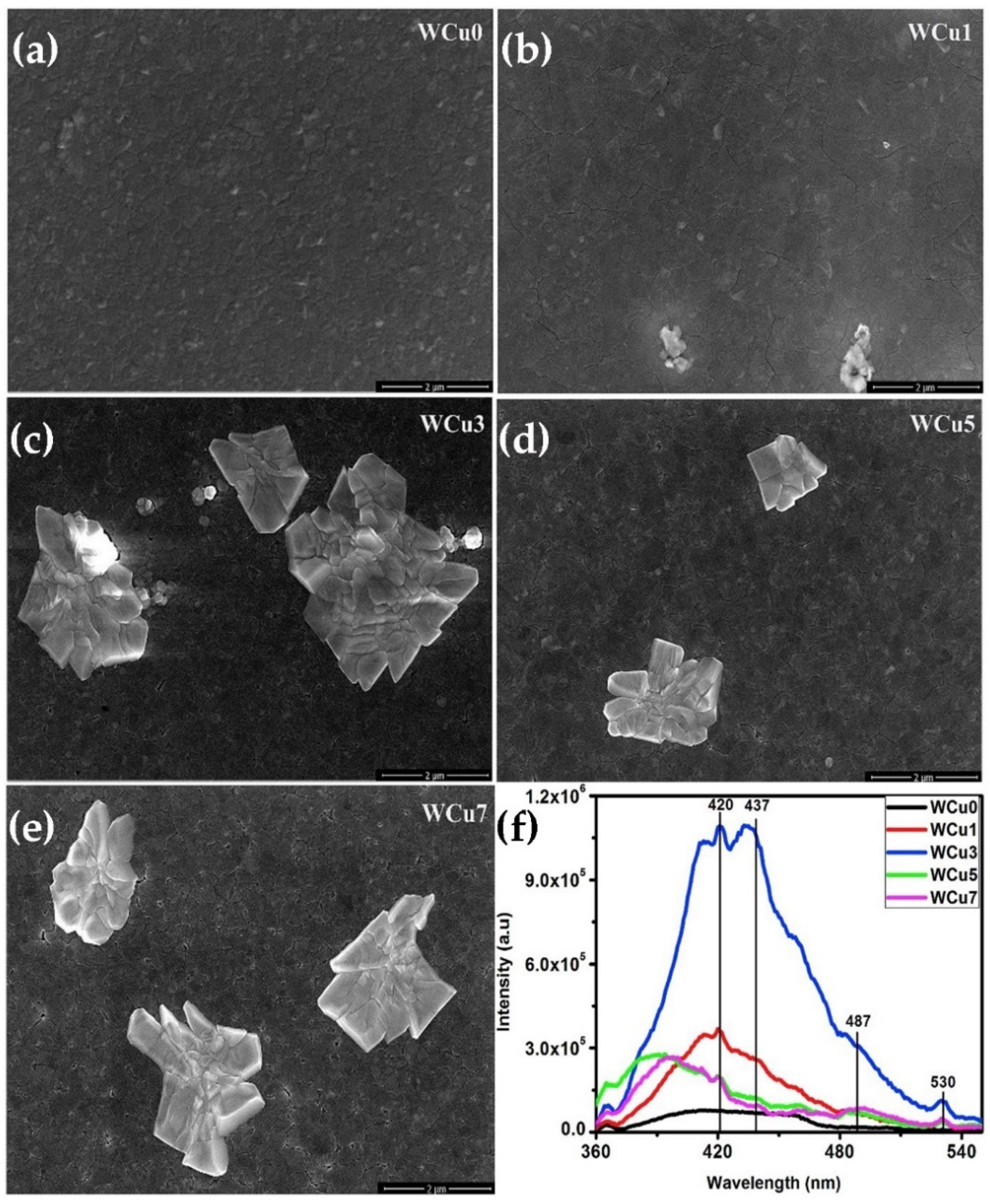
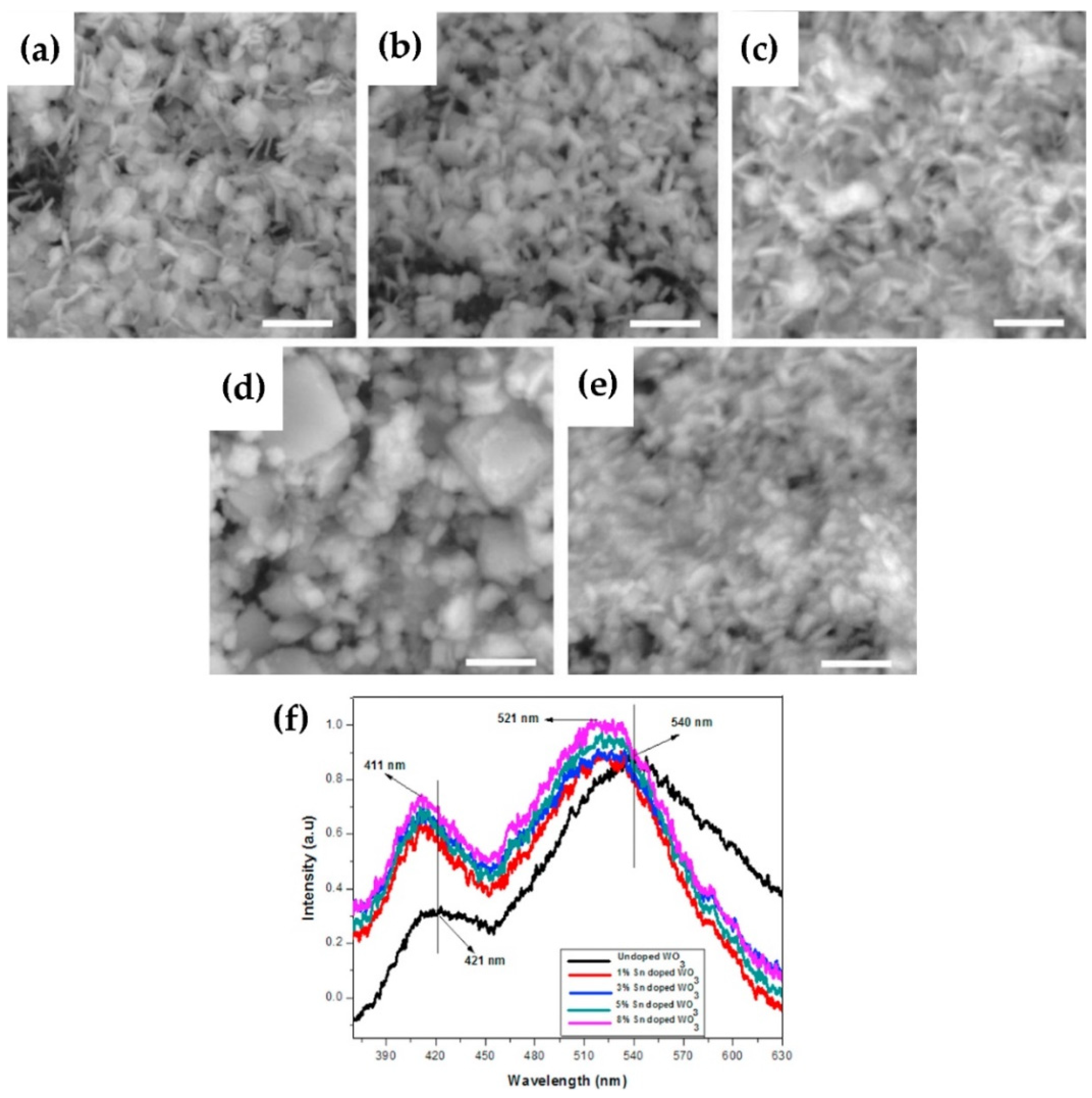
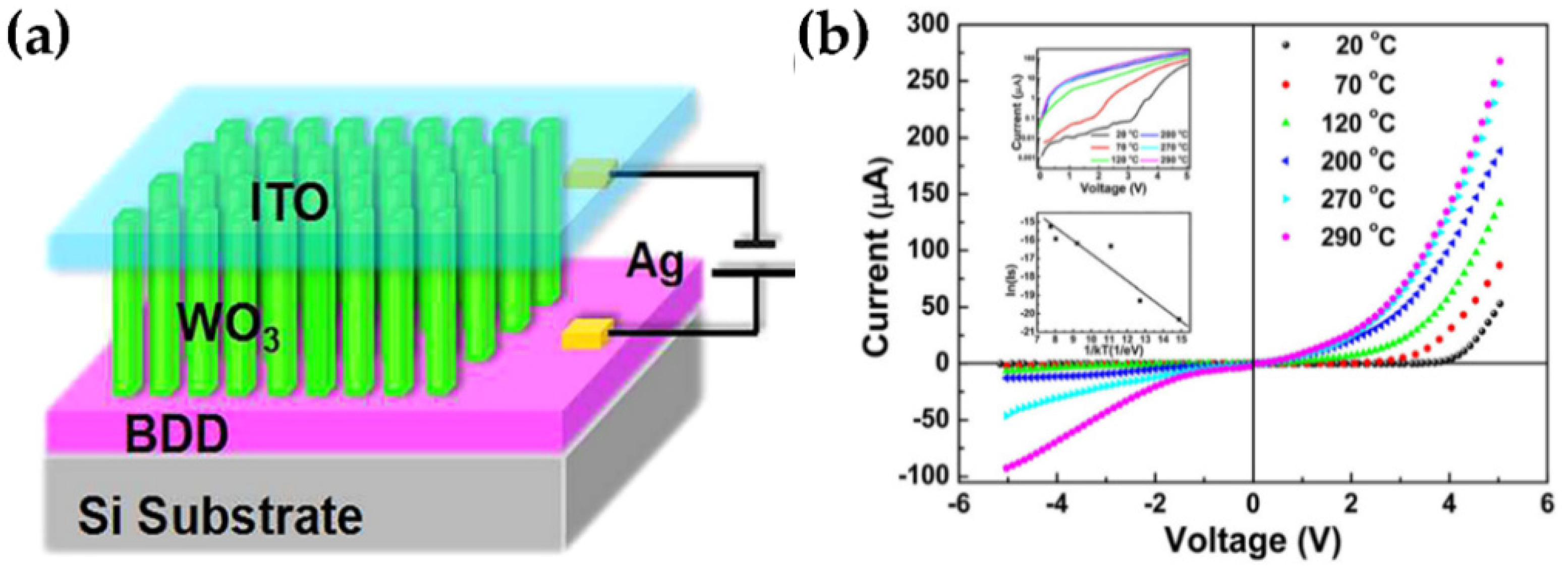
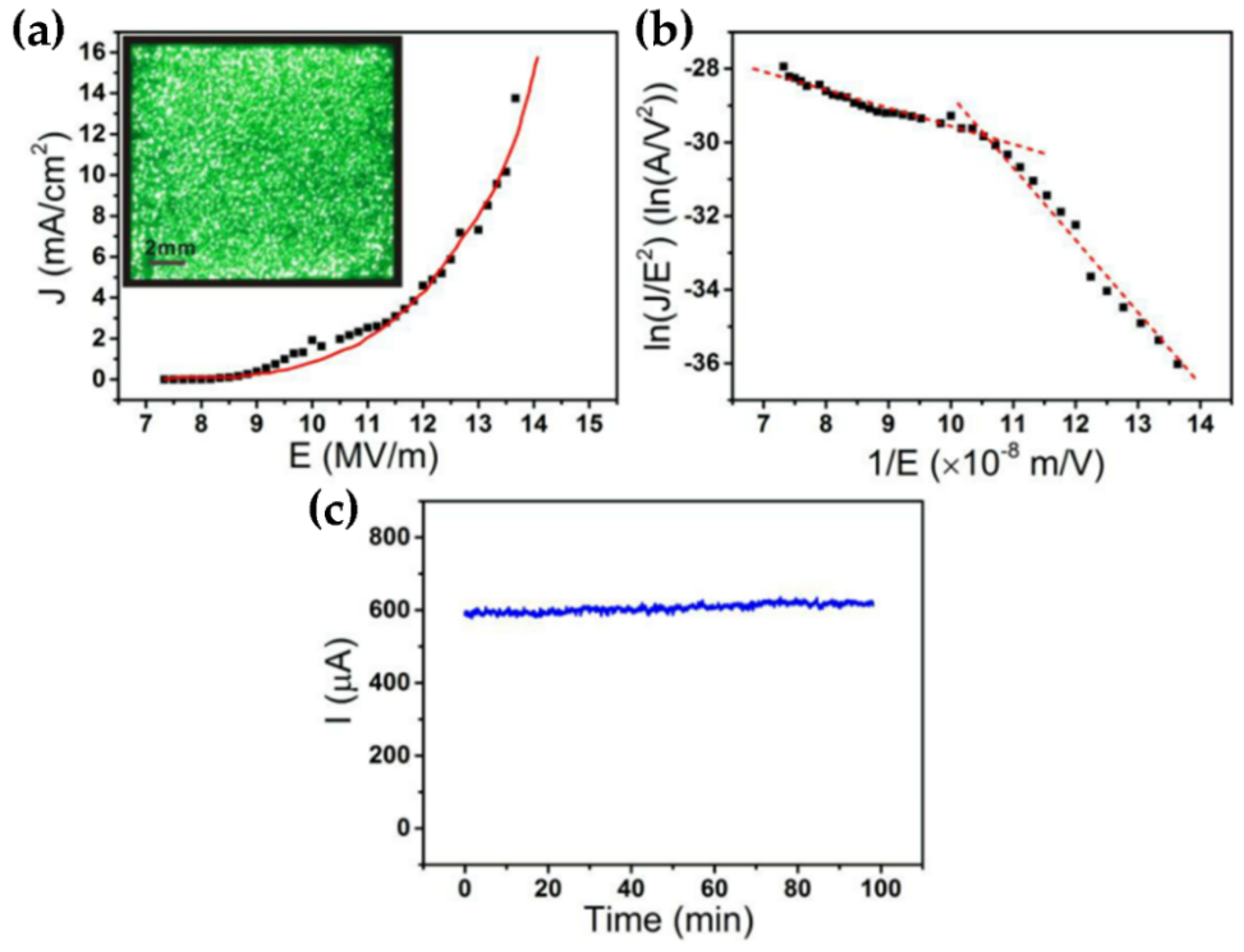
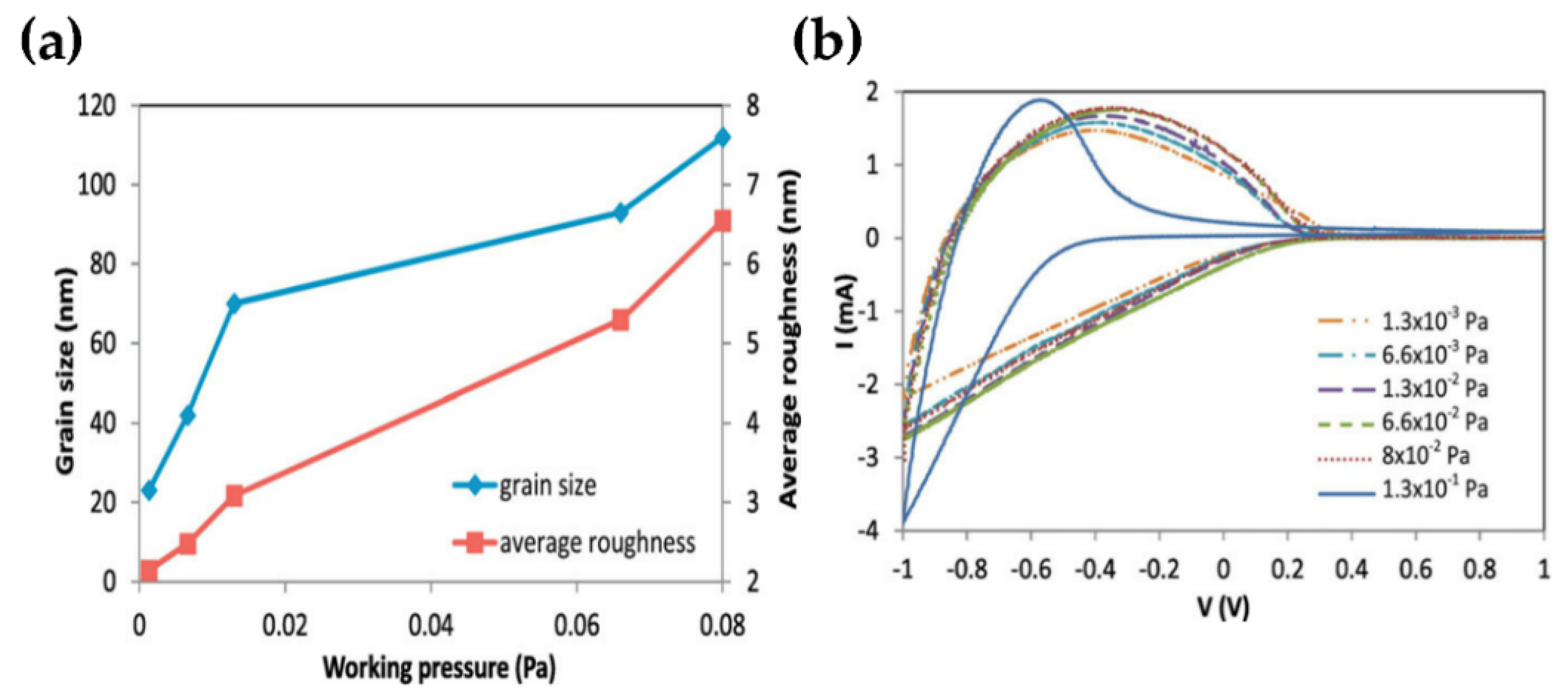
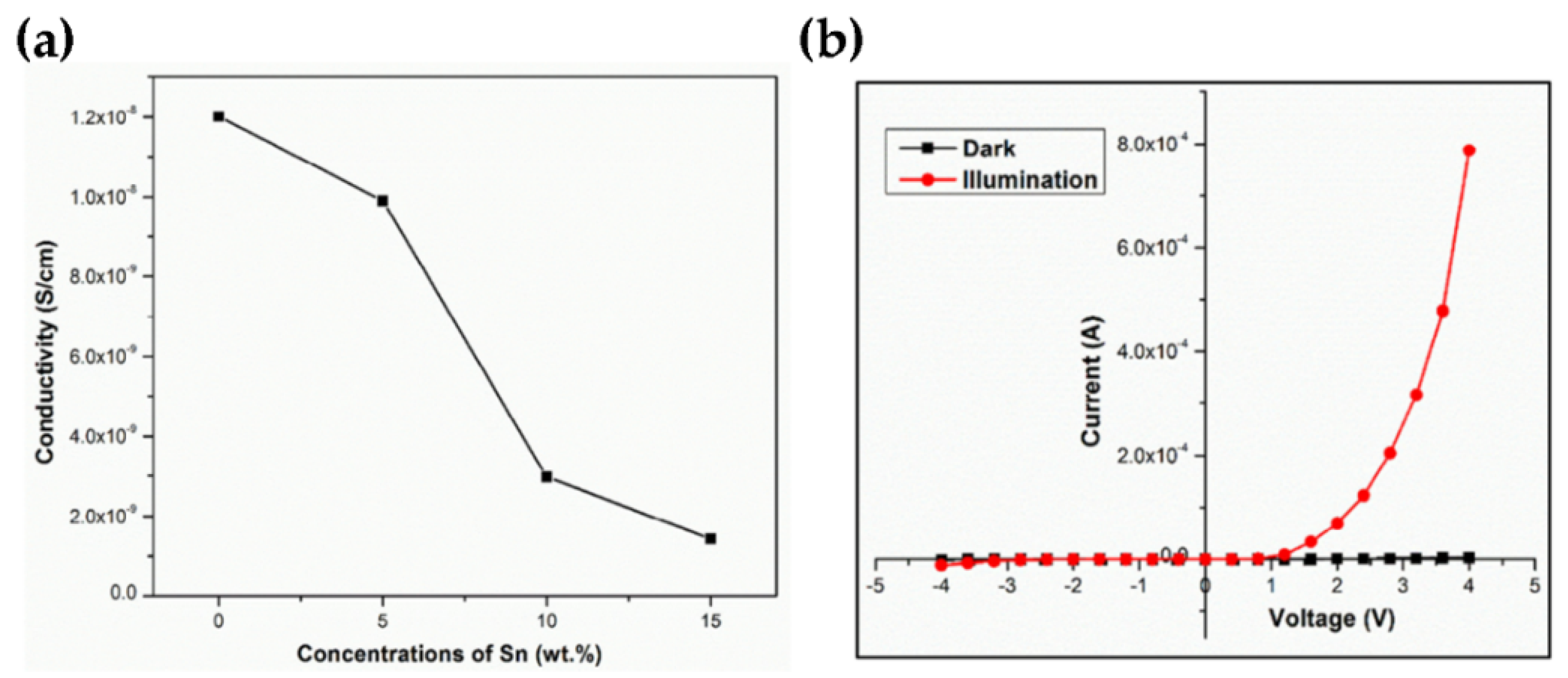
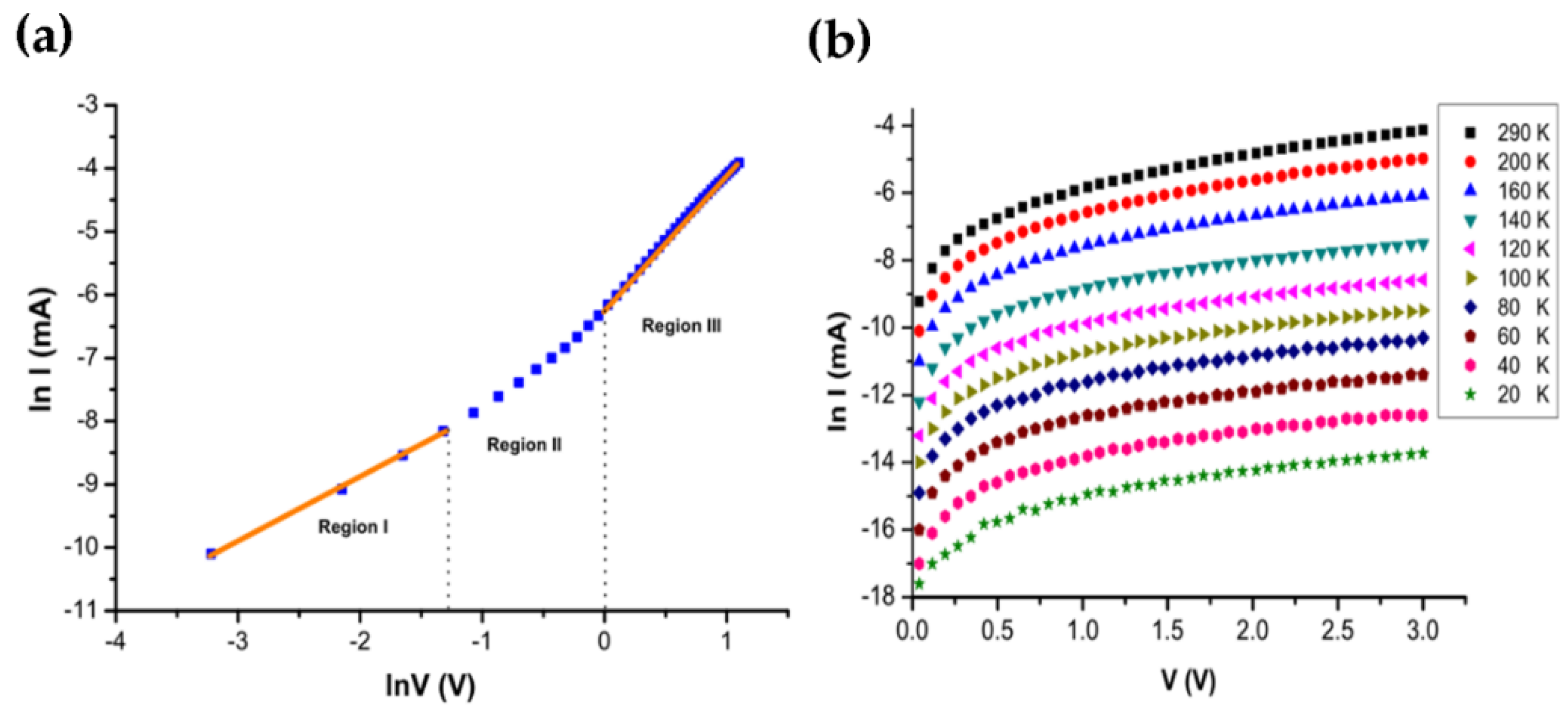
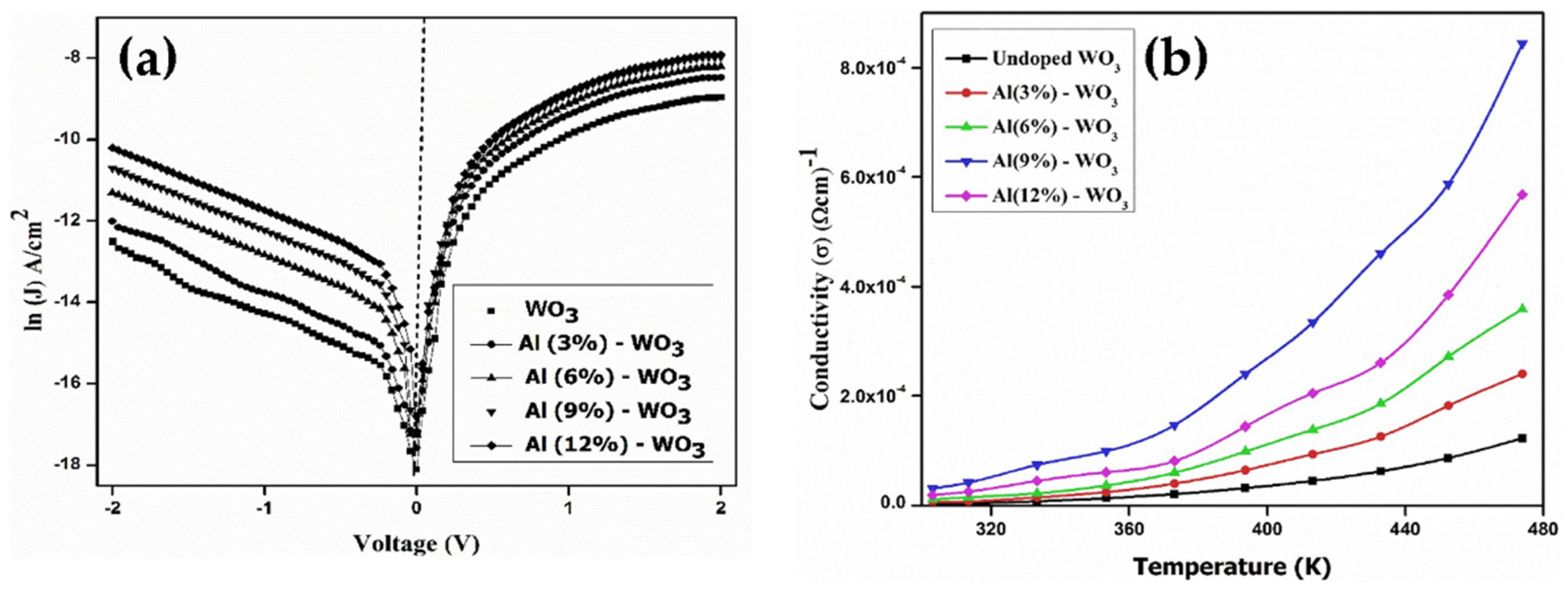
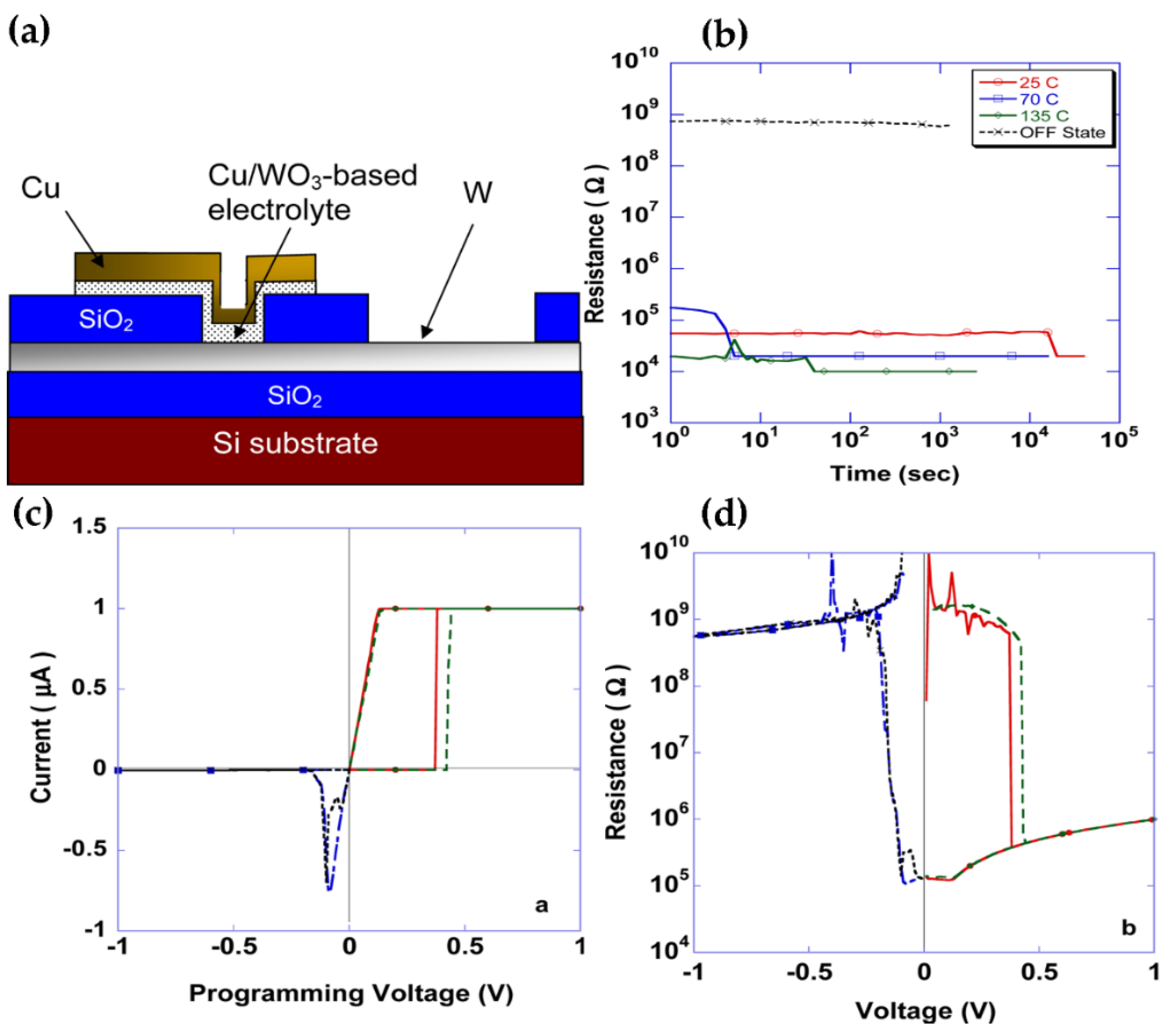
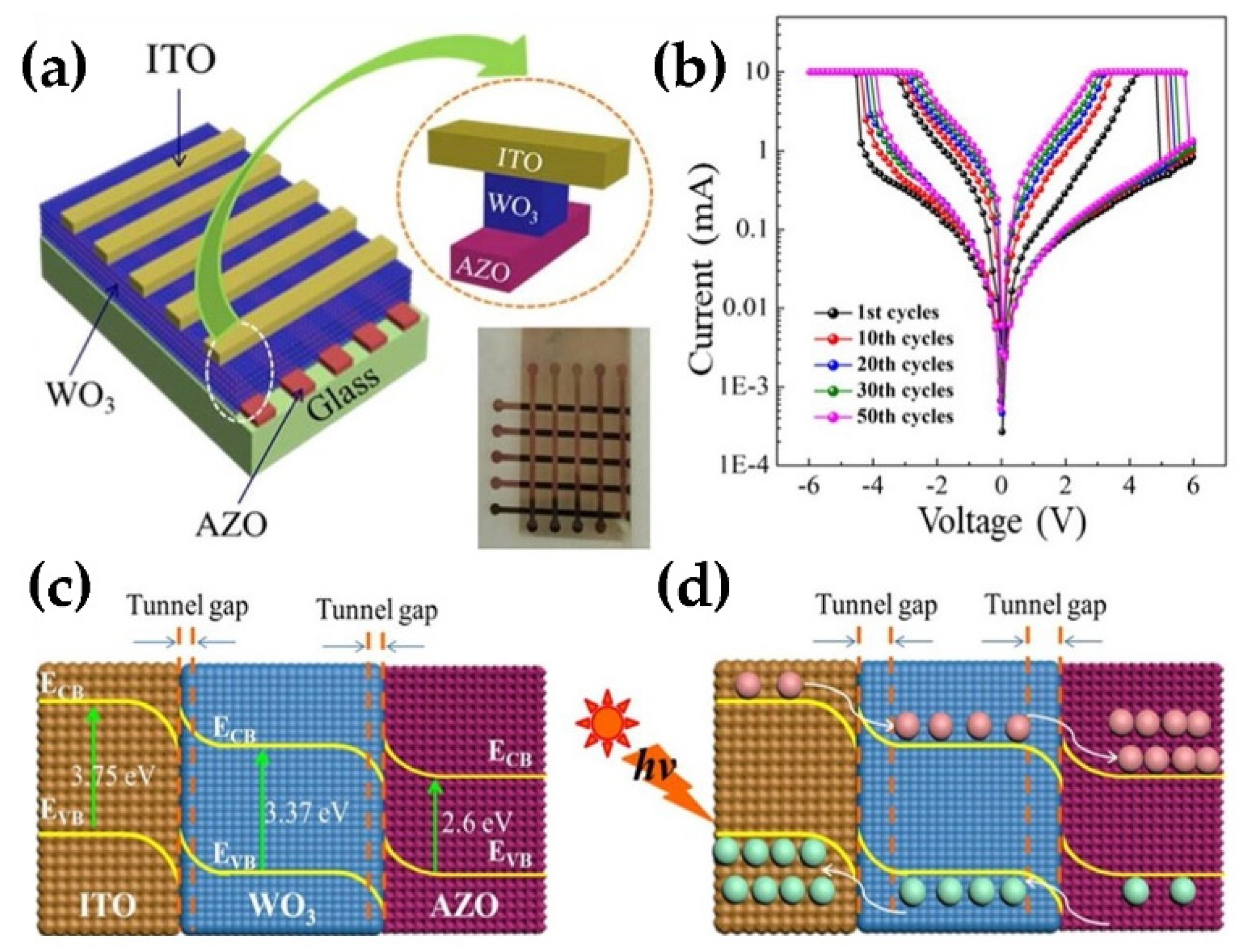
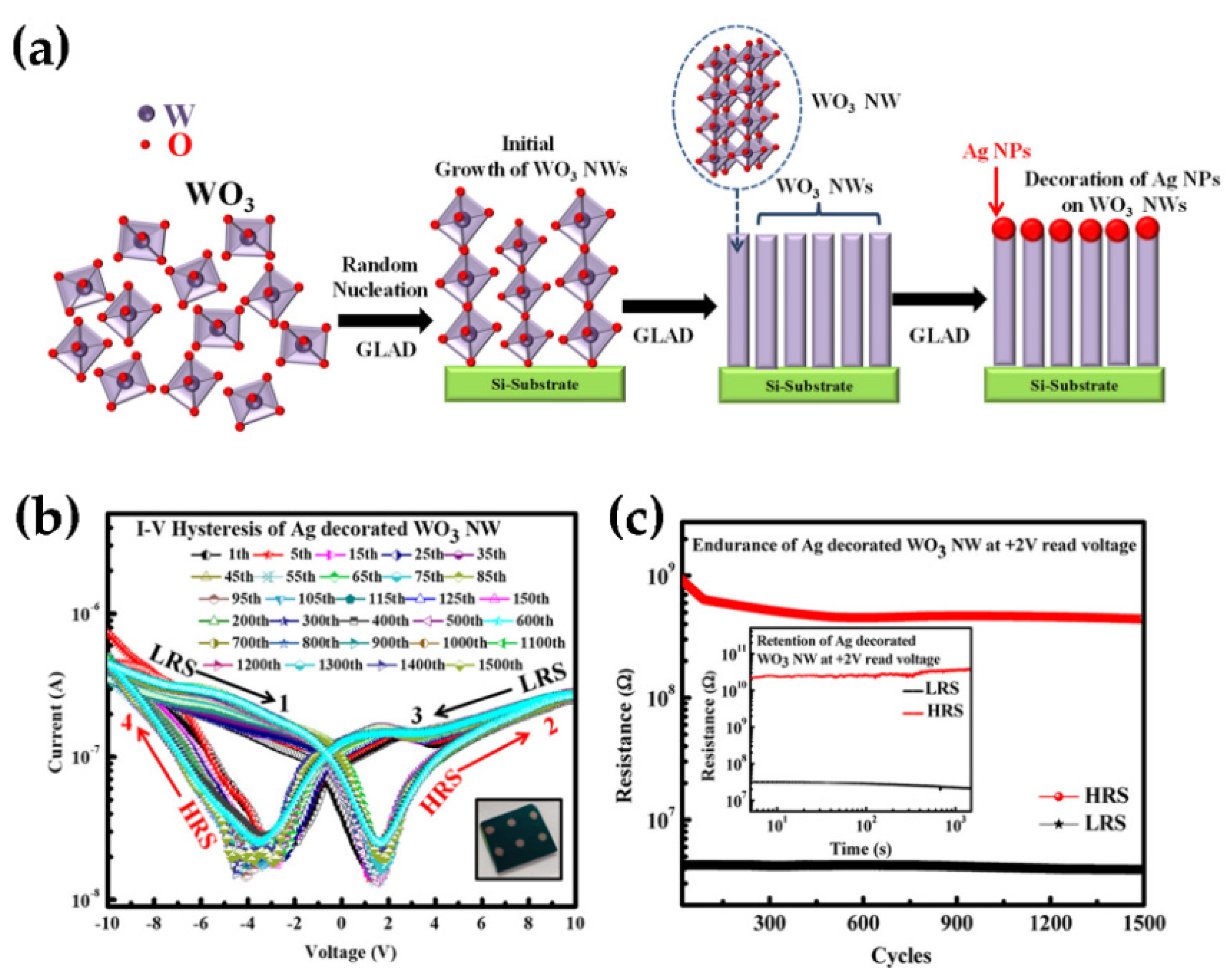
Publisher’s Note: MDPI stays neutral with regard to jurisdictional claims in published maps and institutional affiliations. |
© 2021 by the authors. Licensee MDPI, Basel, Switzerland. This article is an open access article distributed under the terms and conditions of the Creative Commons Attribution (CC BY) license (https://creativecommons.org/licenses/by/4.0/).
Share and Cite
Yao, Y.; Sang, D.; Zou, L.; Wang, Q.; Liu, C. A Review on the Properties and Applications of WO3 Nanostructure−Based Optical and Electronic Devices. Nanomaterials 2021, 11, 2136. https://doi.org/10.3390/nano11082136
Yao Y, Sang D, Zou L, Wang Q, Liu C. A Review on the Properties and Applications of WO3 Nanostructure−Based Optical and Electronic Devices. Nanomaterials. 2021; 11(8):2136. https://doi.org/10.3390/nano11082136
Chicago/Turabian StyleYao, Yu, Dandan Sang, Liangrui Zou, Qinglin Wang, and Cailong Liu. 2021. "A Review on the Properties and Applications of WO3 Nanostructure−Based Optical and Electronic Devices" Nanomaterials 11, no. 8: 2136. https://doi.org/10.3390/nano11082136
APA StyleYao, Y., Sang, D., Zou, L., Wang, Q., & Liu, C. (2021). A Review on the Properties and Applications of WO3 Nanostructure−Based Optical and Electronic Devices. Nanomaterials, 11(8), 2136. https://doi.org/10.3390/nano11082136





